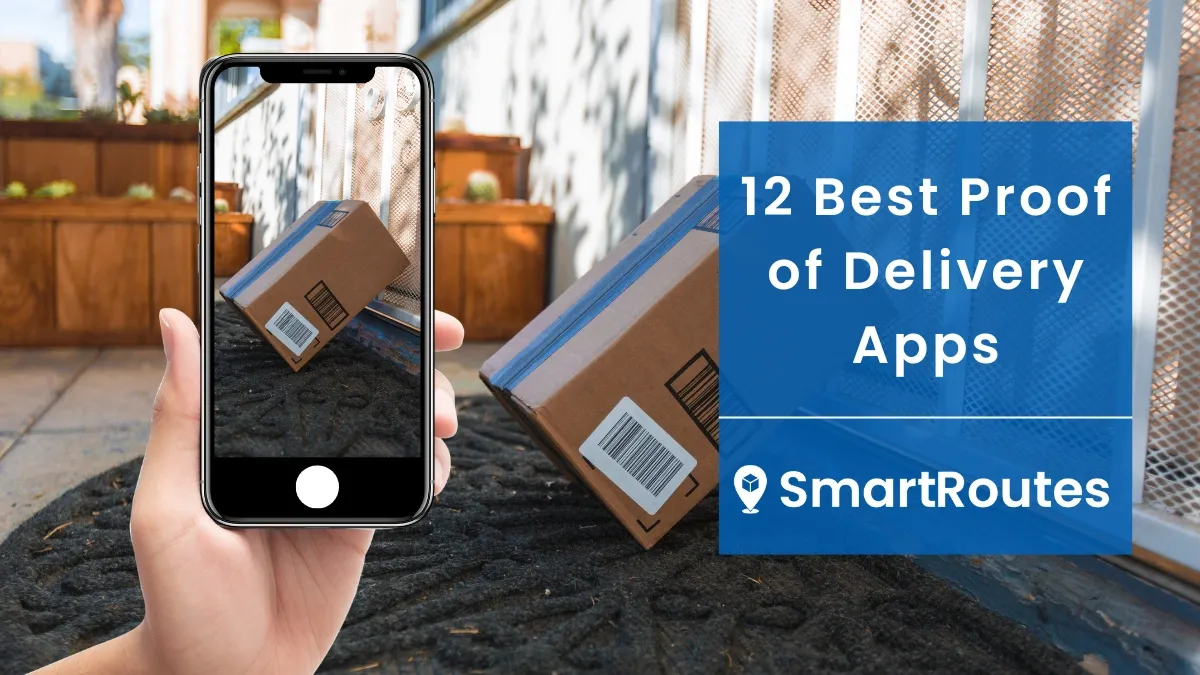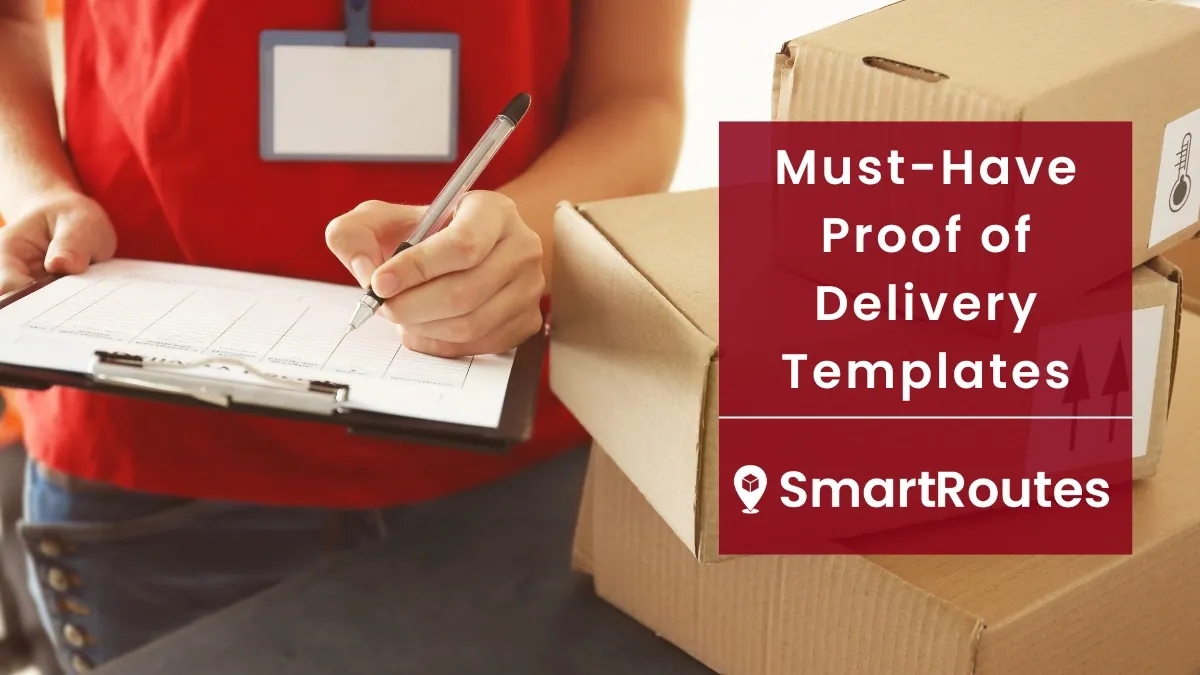What is Proof of Delivery?
Learn about proof of delivery (POD) and how electronic POD solutions, can benefit your business. Improve customer satisfaction and streamline delivery management with efficient POD tracking.
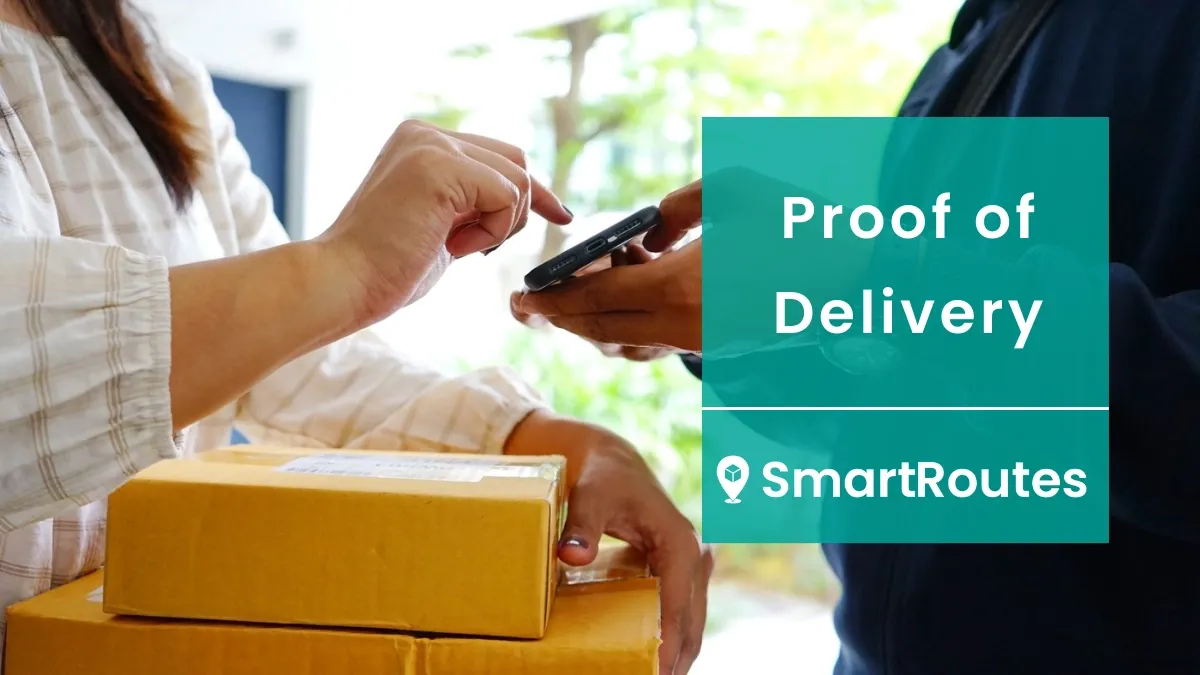
Proof of delivery (POD) is a crucial aspect of logistics and e-commerce, ensuring that businesses and customers can verify that goods have been delivered as intended. In today's digital landscape, there are various ways to collect POD. However, with different carriers, regulations, and customer expectations, managing POD can pose significant challenges, consuming valuable time.
In this blog, we aim to comprehensively explore proof of delivery solutions, including its definition, the importance of proof of delivery in logistics, methods of collection and more.
Whether you are a small business owner, logistics manager, or e-commerce seller, understanding and optimizing POD can help you enhance customer satisfaction, reduce disputes and errors, and improve your overall delivery performance.
Let's discover how to make it work for your business:
What Information is Included in PODs?
Different Forms of Proof of Delivery
Why is Proof of Delivery Important?
Bill of Lading vs Proof of Delivery?
Benefits of Proof of Delivery for Businesses
Why Electronic Proof of Delivery Software is the Best Choice
How to Capture Proof of Delivery with SmartRoutes
How Electronic Proof of Delivery Works
What is Proof of Delivery?
Proof of delivery, often referred to as POD or ePOD (electronic proof of delivery), serves as an acknowledgment of delivery and is provided as documentation or evidence confirming the successful transfer of goods from a sender to a recipient. It acts as a receipt, validating that the recipient has received the correct items in satisfactory condition and within the specified timeframe.
POD is essential for businesses and customers alike as it helps to prevent disputes, errors, and fraud, and to ensure compliance with regulations and service level agreements.
Traditionally, POD was acquired through physical signatures on paper. However, with the advent of digital advancements, electronic methods such as proof of delivery apps and barcode scanning have become prevalent. Digital proof of delivery systems offer increased efficiency and accessibility.
Overall, optimizing the accuracy, accessibility, and efficiency of POD is essential for businesses to enhance customer satisfaction, minimize costs, and maintain a competitive advantage in the delivery process.
SmartRoutes Proof of Delivery Software
Streamline your entire delivery process, all from one platform

What Information is Included in PODs?
PODs generally encompass a variety of crucial delivery information, including:
- Recipient's name
- Recipient's address
- Date and time of delivery
- Recipient's signature and/or photo verification
Additional details that might feature in PODs comprise:
- Carrier name and logo
- Specific order details
- Quantity and weight of items delivered
- Order number
- Tracking number
Different Forms of Proof of Delivery
Paper Proof of Delivery
Paper-based PODs and Delivery Notes are straightforward documents filled out manually by a driver, with the end-customer signing the delivery note to confirm receipt of the goods.
To ensure both the end-customer and the driver have copies of the POD, a triplicate book is commonly used. This book duplicates each completed page on the reverse side, saving time for the driver and eliminating any discrepancies between PODs.
Electronic Proof of Delivery [ePOD]
ePODs and digital delivery notes are captured directly on a driver's smartphone or tablet, recording all necessary delivery data. With driver apps consolidating various functions like route navigation, dispatch notes, and order details, it's convenient for drivers to record paperless POD within the same interface. These apps can also capture eSignatures from customers and scan barcodes to document the POD.
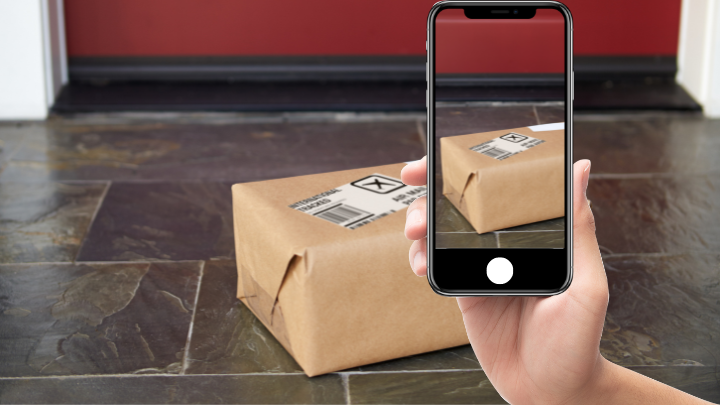
Integration of ePODs within mobile apps has introduced photo proof of delivery. In instances where the customer is absent, this serves as indisputable evidence of when and where delivery occurred, utilizing geo-location technology to record the driver's smartphone location when marking the delivery as complete. ePODs are accessible in real-time for both office staff and customers, providing transparency throughout the delivery process.
Why is Proof of Delivery Important?
As the name suggests, proof of delivery is the record of goods being delivered to their pre-specified location, complete with all details pertaining to the delivery. Acting as an acknowledgment between the sender and the recipient, it confirms the successful delivery of goods and documents the time of delivery.
The rise of eCommerce has led to a substantial increase in direct-to-consumer deliveries. As online shopping continues to grow, with global eCommerce logistics projected to grow at an average yearly rate of over 10% until 2027, the need for efficient proof of delivery solutions becomes paramount.
Also, with the convenience of contactless deliveries, customers may not always be present to receive their packages, raising concerns about package theft. Investing in robust proof of delivery technology becomes essential to mitigate this risk.
Business owners use proof of delivery to:
- Maintain accurate records of deliveries
- Enhance delivery performance and efficiency
- Ensure timely deliveries
- Mitigate costly disputes and discrepancies
- Improve customer satisfaction through transparency and accountability
- Facilitate real-time tracking of deliveries for both businesses and customers
- Streamline logistics operations and optimize delivery routes
- Comply with regulatory requirements and service level agreements
Bill of Lading vs Proof of Delivery?
Billing of Lading (BOL) is a legally binding document issued by a carrier, acknowledging the receipt of goods for shipment. It functions as a contract of carriage among the shipper, carrier, and consignee, detailing the type of goods, destination, and payment terms.
Although BOL and Proof of Delivery (POD) both document delivery, they differ in several respects. BOL is predominantly utilized in the shipping industry and is provided by the carrier upon shipment initiation, while POD finds broader application across industries and is generated upon delivery. It's worth noting that while BOLs are typically legally required, depending on the region, PODs are not mandated by law.
Furthermore, BOL offers a more comprehensive scope compared to POD, encompassing details like the carrier's liability, consignee's particulars, and special delivery instructions. Additionally, BOL serves as a legal instrument in settling disputes or claims concerning the shipment, whereas POD primarily serves to confirm delivery for both the shipper and consignee.
Benefits of Proof of Delivery for Businesses
Avoiding disputes and errors: POD helps to prevent disputes or claims from customers who allege they did not receive their items or received orders with visible damage. By providing documented proof of delivery, businesses can reduce the risks of misunderstandings, legal issues and reputational damage.
Improving customer satisfaction: POD can enhance customers' trust and confidence in a business by providing clear confirmation that orders are fulfilled and delivered as expected. This can lead to higher satisfaction rates, better customer retention, and positive reviews.
Boosting transparency and accountability: POD provides a transparent and accountable record of the delivery process, showing who delivered the items, when, and where. This can help to deter fraud, theft, or mismanagement, and increase the trust between businesses and their customers.
Enhancing operational efficiency: Electronic proof of delivery systems aids businesses in monitoring and analyzing delivery performance, pinpointing bottlenecks, and refining logistics processes. This results in cost savings, expedited delivery times, and optimized resource allocation. For instance, leveraging electronic POD minimizes manual paperwork, conserves storage space, and enhances data accuracy.
Ensuring compliance: Regulatory bodies, insurance firms, and service level agreements often mandate POD to ensure businesses adhere to necessary procedures and meet required standards. Non-compliance can incur penalties, fines, or legal repercussions. Thus, providing POD is essential for maintaining regulatory compliance and safeguarding business interests.
Issues with using Paper POD
Paper POD is very inefficient method, for many reasons:
1. Time consuming: The manual nature of paper PODs contributes to significant time consumption. Drivers must locate and physically fill out paper proof of delivery documents, which can prolong the delivery process, especially during peak periods or when multiple deliveries are scheduled.
2. Difficult to store: While manageable on a small scale, the storage of paper PODs becomes increasingly cumbersome as delivery volumes grow. The physical space required to store paper documents escalates, posing logistical challenges and potentially leading to disorganization.
3. Non-searchable database: Retrieving specific PODs from a pile of paper documents can be akin to finding a needle in a haystack. When disputes or inquiries arise, the lack of a searchable database makes it arduous to locate and present the necessary proof of delivery promptly.
4. Human error: Manual data entry in paper PODs is susceptible to human error. Mistakes such as recording incorrect details, omitting sections, or forgetting to document deliveries altogether are common pitfalls. These errors can compromise the accuracy and reliability of the delivery records.
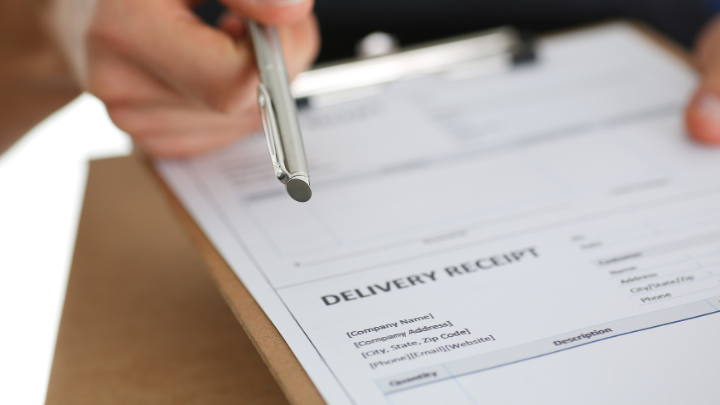
5. Easily damaged: Paper PODs are vulnerable to damage and deterioration, especially when not stored properly. A single mishap, such as spills or tears, can render the document unreadable, jeopardizing the ability to provide conclusive delivery confirmation. This vulnerability increases the risk of disputes and challenges to the delivery's legitimacy.
6. Frustrated customers: The inconvenience of paper PODs extends to customers, who may find the process of waiting to provide details and sign for orders burdensome. Lengthy paperwork procedures can lead to customer dissatisfaction and impede the overall delivery experience.
Given these challenges, electronic proof of delivery emerges as a clear and compelling solution to streamline delivery operations, enhance efficiency, and improve customer satisfaction.
Why Electronic Proof of Delivery Software is the Best Choice
Better Efficiency through Automation
Electronic proof of delivery systems streamline the process of collecting PODs by eliminating the need for manual paperwork. Drivers can swiftly record delivery details directly into digital platforms, saving time and reducing administrative burden. Automation minimizes the risk of human error inherent in manual data entry. By digitizing the POD process, businesses can ensure greater accuracy in recording delivery details, reducing discrepancies and potential disputes.
Available in Real-time
POD software makes proof of delivery instantly available to office staff in real-time. This eliminates the need to wait for drivers to return to the office before accessing delivery information. Real-time accessibility ensures swift response to customer inquiries and enhances overall service efficiency.
Delivery Experience
Electronic proof of delivery enhances the delivery experience for customers by expediting the process. With digital documentation, customers no longer need to wait for manual paperwork to be completed, resulting in quicker and more seamless transactions. Drivers can easily access ePODs through mobile apps, eliminating the need to sift through physical documents. This enhances their efficiency and enables them to focus on delivering exceptional service to customers.
How to Capture Proof of Delivery with SmartRoutes
SmartRoutes proof of delivery software for iPhone & Android allows you to create routes and attach all the relevant details to each order and stop for the driver. These are all available to the driver and pre-populate on the ePOD.
Our Driver Mobile app allows the driver to quickly take a photo of the delivery which is available for the admin team to view in real time. In addition, the app utilizes sign-in glass technology to capture the signature of the recipient.
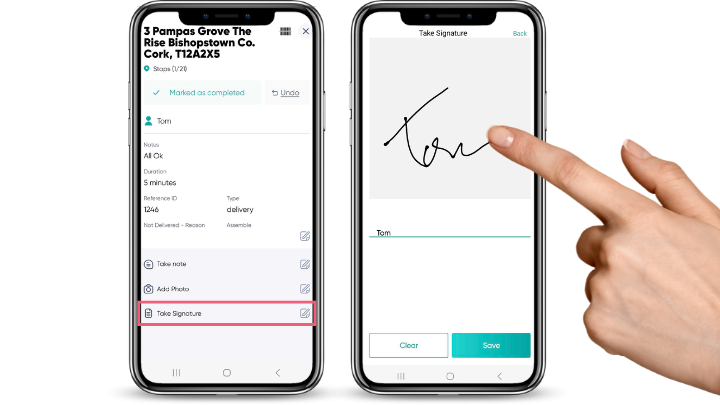
Once drivers capture notes, eSignatures, photos of deliveries and/or scans barcodes, these ePODs are instantly attached to the stop on the Live Routes Dashboard back at the office or depot.
Our electronic POD also collects geo-stamps and time-stamps at the points and time the delivery was marked as delivered in the driver app.
This centralized platform enables office staff to monitor delivery progress and access delivery details in real-time.
SmartRoutes offers a comprehensive proof of delivery report, allowing you to easily view the status of all PODs. This report provides valuable insights into delivery performance and helps in resolving any discrepancies or inquiries efficiently.
You can also view proof of deliveries at the individual stop level by clicking on the stop. View the eSignature and photos taken plus the time the delivery was completed.
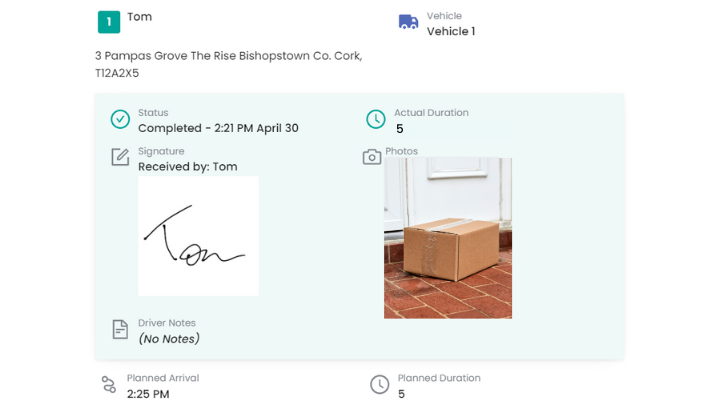
This simple, yet effective process can save your drivers up to a minute on each stop by eliminating the need to fill delivery notes manually. If your driver completes 70 stops, that’s over an hour a day. It can also save your support staff up to 75% of time spent serving customer queries about deliveries.
As anyone who has operated a delivery service knows, this has the potential to radically optimise the way your employees work and enables you to serve more stops with fewer vehicles on a daily basis.
How Electronic Proof of Delivery Works
Electronic proof of delivery (ePOD) simplifies the process of documenting successful deliveries, providing real-time visibility and efficiency throughout the delivery workflow. Here's how route planning software facilitates the capture of ePOD:
Capture Upon Delivery: Upon successful delivery, the delivery driver utilizes the SmartRoutes mobile app to capture the ePOD directly. These PODs are instantly associated with the completed order and are accessible in real-time by office staff.
Multiple Capture Methods: There are a number of versatile options for capturing ePOD, ensuring flexibility and accuracy in documentation. These methods include:
- E-Signature: Recipients can provide electronic signatures within the mobile app, confirming receipt of the delivery.
- Photo: Drivers can capture photos of the delivered items as proof of condition or placement.
- Barcode Scan: Barcode scanning functionality enables quick and accurate recording of delivered items, streamlining data entry.
- Geotagging: Routing software automatically captures the delivery location and timestamps once the delivery is marked as 'done,' providing precise information about when and where the delivery was completed.
Why SmartRoutes is the Best Proof of Delivery Software
SmartRoutes is the best proof of delivery software that offers a simple and efficient way to ensure that your deliveries are completed successfully and that you have a complete digital trail of all your deliveries. All the data captured by the Driver Mobile app is securely stored in the cloud, and you can access it at any time through our web-based platform. This makes it easy to track deliveries, resolve any disputes, and optimize your delivery operations.
Start capturing POD effectively and efficiently today by signing up for a 7 day free trial!
Frequently asked questions
1. What does proof of delivery mean?
A Proof of Delivery (POD) is a document or digital record that confirms the successful delivery of goods or services to a customer. It typically includes important information like the recipient's signature, delivery date, time, and sometimes even photos or GPS coordinates.
2. Why is proof of delivery important for businesses?
Proof of delivery is crucial for businesses as it helps establish a clear record of completed deliveries. It enhances customer trust, reduces disputes, and provides evidence in case of delivery issues, ensuring accountability in the supply chain.
3. How do you collect proof of delivery?
Proof of delivery can be collected through various methods such as obtaining the recipient's signature, capturing photos of delivered items, using barcode scanning, or utilizing GPS tracking to record the delivery location and time.
4. Which industries use proof of delivery?
Proof of delivery is utilized across a wide range of industries including third-party logistics and couriers, retail and ecommerce, furniture delivery, pharmaceutical and medical devices, food delivery, and many others.
5. What are the best proof of delivery software options?
Some popular proof of delivery software options include SmartRoutes, Onfleet, Bringg, WorkWave, and Detrack. These platforms offer features such as real-time tracking, electronic signatures, photo capture, and route optimization to streamline delivery operations.
6. Is proof of delivery a legal requirement?
The legal requirement for proof of delivery varies depending on jurisdiction and industry regulations. While proof of delivery is not always mandated by law, it is commonly required by businesses to protect themselves in case of disputes or legal issues. Additionally, certain industries or types of shipments may have specific legal requirements for proof of delivery. It's important for businesses to understand the legal requirements applicable to their operations.
If you enjoyed this blog, you might also be interested in:
